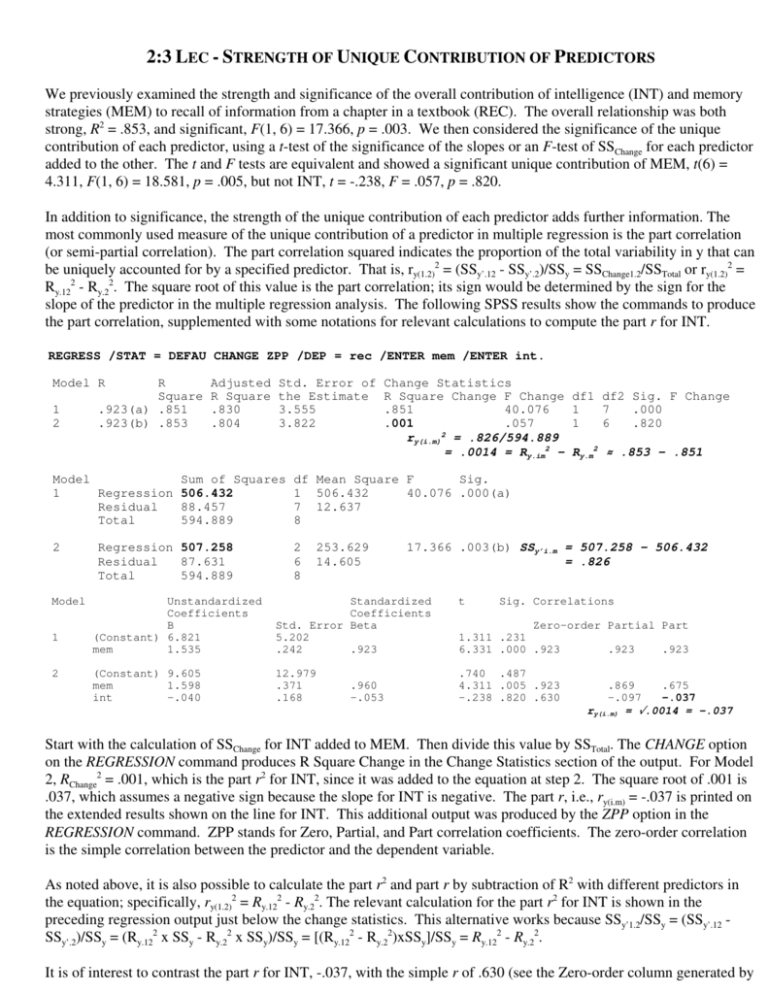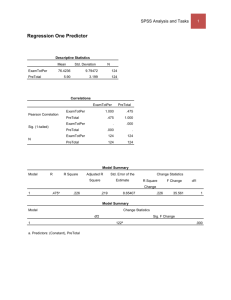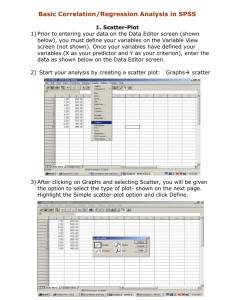2:3 lec - strength of unique contribution of predictors
advertisement

2:3 LEC - STRENGTH OF UNIQUE CONTRIBUTION OF PREDICTORS We previously examined the strength and significance of the overall contribution of intelligence (INT) and memory strategies (MEM) to recall of information from a chapter in a textbook (REC). The overall relationship was both strong, R2 = .853, and significant, F(1, 6) = 17.366, p = .003. We then considered the significance of the unique contribution of each predictor, using a t-test of the significance of the slopes or an F-test of SSChange for each predictor added to the other. The t and F tests are equivalent and showed a significant unique contribution of MEM, t(6) = 4.311, F(1, 6) = 18.581, p = .005, but not INT, t = -.238, F = .057, p = .820. In addition to significance, the strength of the unique contribution of each predictor adds further information. The most commonly used measure of the unique contribution of a predictor in multiple regression is the part correlation (or semi-partial correlation). The part correlation squared indicates the proportion of the total variability in y that can be uniquely accounted for by a specified predictor. That is, ry(1.2)2 = (SSy’.12 - SSy’.2)/SSy = SSChange1.2/SSTotal or ry(1.2)2 = Ry.122 - Ry.22. The square root of this value is the part correlation; its sign would be determined by the sign for the slope of the predictor in the multiple regression analysis. The following SPSS results show the commands to produce the part correlation, supplemented with some notations for relevant calculations to compute the part r for INT. REGRESS /STAT = DEFAU CHANGE ZPP /DEP = rec /ENTER mem /ENTER int. Model R 1 2 R Square .923(a) .851 .923(b) .853 Model 1 Regression Residual Total 2 Model 1 2 Adjusted R Square .830 .804 Std. Error of the Estimate 3.555 3.822 Sum of Squares 506.432 88.457 594.889 Regression 507.258 Residual 87.631 Total 594.889 Change Statistics R Square Change F Change .851 40.076 .001 .057 ry(i.m)2 = .826/594.889 = .0014 = Ry.im2 - df1 df2 Sig. F Change 1 7 .000 1 6 .820 Ry.m2 .853 - .851 df Mean Square F Sig. 1 506.432 40.076 .000(a) 7 12.637 8 2 6 8 253.629 14.605 17.366 .003(b) SSy’i.m = 507.258 - 506.432 = .826 Unstandardized Coefficients B (Constant) 6.821 mem 1.535 Standardized Coefficients Std. Error Beta 5.202 .242 .923 t (Constant) 9.605 mem 1.598 int -.040 12.979 .371 .168 .740 .487 4.311 .005 .923 -.238 .820 .630 .960 -.053 Sig. Correlations Zero-order Partial Part 1.311 .231 6.331 .000 .923 .923 .923 .869 .675 -.097 -.037 ry(i.m) = .0014 = -.037 Start with the calculation of SSChange for INT added to MEM. Then divide this value by SSTotal. The CHANGE option on the REGRESSION command produces R Square Change in the Change Statistics section of the output. For Model 2, RChange2 = .001, which is the part r2 for INT, since it was added to the equation at step 2. The square root of .001 is .037, which assumes a negative sign because the slope for INT is negative. The part r, i.e., ry(i.m) = -.037 is printed on the extended results shown on the line for INT. This additional output was produced by the ZPP option in the REGRESSION command. ZPP stands for Zero, Partial, and Part correlation coefficients. The zero-order correlation is the simple correlation between the predictor and the dependent variable. As noted above, it is also possible to calculate the part r2 and part r by subtraction of R2 with different predictors in the equation; specifically, ry(1.2)2 = Ry.122 - Ry.22. The relevant calculation for the part r2 for INT is shown in the preceding regression output just below the change statistics. This alternative works because SSy’1.2/SSy = (SSy’.12 SSy’.2)/SSy = (Ry.122 x SSy - Ry.22 x SSy)/SSy = [(Ry.122 - Ry.22)xSSy]/SSy = Ry.122 - Ry.22. It is of interest to contrast the part r for INT, -.037, with the simple r of .630 (see the Zero-order column generated by the ZPP option). Note how a sizable positive correlation (.630) has become tiny and even slightly negative (-.037) once its correlation with MEM is controlled. The original simple correlation was positive and large because people high on intelligence (i.e., high on INT) tended to use good memory strategies (i.e., high on MEM), which was related to performance (i.e., the criterion variable REC). Controlling for MEM eliminated the connection between INT and REC. Work through the part correlation for MEM using the following analysis. REGRESS /STAT = DEFAU CHANGE ZPP /DEP = rec /ENTER int /ENTER mem. Model R 1 2 R Square .630(a) .397 .923(b) .853 Model 1 Regression Residual Total 2 Model 1 2 Adjusted R Square .310 .804 Std. Error of the Estimate 7.162 3.822 Sum of Squares 235.878 359.011 594.889 Regression 507.258 Residual 87.631 Total 594.889 Change Statistics R Square Change F Change df1 df2 Sig. F Change .397 4.599 1 7 .069 .456 18.581 1 6 .005 df Mean Square F 1 235.878 4.599 7 51.287 8 2 6 8 253.629 14.605 Sig. .069(a) 17.366 .003(b) Unstandardized Coefficients B (Constant) -9.772 int .474 Standardized Coefficients Std. Error Beta 22.815 .221 .630 t (Constant) 9.605 int -.040 mem 1.598 12.979 .168 .371 .740 .487 -.238 .820 .630 4.311 .005 .923 -.053 .960 Sig. Correlations Zero-order Partial Part -.428 .681 2.145 .069 .630 .630 .630 -.097 .869 -.037 .675 Although the contribution of MEM remains significant and moderately strong even with INT in the equation, FChange = 18.581, tm.i = 4.311, p = .005, rr(m.i)2 = .6752 = .456, note that the strength is considerably reduced with INT controlled statistically (i.e., .675 is weaker than .923, the simple correlation between recall and memory strategy). This is because some, but not all, of what MEM could predict when used alone was due to variability in MEM that was shared with INT. Theoretically, INT MEM REC, but INT is not the only source of variability in MEM, so that even when INT is controlled, there is still variation in MEM that is related to recall. Note that the sum of the unique contributions of the two predictors does not add up to the total variability accounted for when both predictors are in the equation; that is, rr(i.m)2 + rr(m.i)2 = -.0372 + .6752 = .457 < .853 = Rr.im2 (this inequality could also be stated in terms of SSs). The other 40% or so of variability in REC that is predictable from INT and MEM is due to variability shared by the two predictors (i.e., area c in the Venn diagrams). Next class we examine a second correlation coefficient representing the unique contribution of a predictor, namely the partial correlation coefficient. The partial correlation coefficient is used less frequently and must be interpreted with much caution, as we will note. To set the stage for the partial correlation, note that SSChange could be calculated by considering SSResidual in Models 1 and 2, rather than SSRegression. We have already noted that the increase in SSRegression from Model 1 to Model 2 must be due to variability moving from SSResidual in Model 1, because SSTotal remains exactly the same in both models. To illustrate for the unique contribution of INT, SSr’i.m = SSResidualModel1 SSResidualModel2 = 88.457 - 87.631 = .826, the same quantity calculated earlier. So SSChange equals not only the increase in SSRegression when one predictor is added to the other, but also the decrease in SSResidual when one predictor is added to the other. Appreciation of this point will help our understanding of partial correlation coefficients. The previous material pointed out that SSChange for a predictor could be considered as either the increase in SSRegression when a new predictor is added to the equation, or as a decrease in SSResidual when a new variable is added. The partial correlation coefficient, ry1.2 (note absence of brackets), can best be conceptualized in terms of the latter view of SSChange. In essence, ry1.22 reflects the proportion of residual variability from Model 1 that is now accounted for in Model 2 with the added predictor. That is, ry1.22 = SSChange / SSResidualModel1 = SSChange / (SSTotal - SSy’.2). Consider SSChange for INT, i.e., SSr’i.m = .826, which gave rr(i.m)2 = .826/594.889 = .0014 for the part correlation squared, and rr(i.m) = .0014 = -.037. Instead of dividing by SSTotal, dividing by SSTotal - SSr’.m = 594.889 - 506.432 = 88.457, gives the partial r2 for INT, rr’i.m2 = .826 / 88.457 = .0093, and rr’i.m = .0093 = .0966. The partial r indicates that intelligence accounts for .93% of the 88.457 units of variability in REC not already accounted for by MEM, whereas the part (or semi-partial) r indicates that intelligence accounts for .14% of the total variability in recall. The partial correlation appears in the ZPP portion of the regression output. The entry for INT, -.097, agrees with the preceding calculations. The negative sign is added because of the negative sign of the slope for INT. The partial r for MEM would be worked out in an analogous fashion. Partial rs must be interpreted with caution. The partial r for INT is much larger than the part r (although still modest because SSChange was so small), not because its contribution to prediction of recall was any stronger but because the contribution of MEM alone was strong, thus removing much of the variability in y from the denominator, and inflating the apparent strength of INT. Although not a measure of strength in the same sense as correlation coefficients, information about the magnitude of the change in y with changes in predictors can also be used to compare the contribution of different predictors. But the unstandardized coefficients that we have considered so far are less than ideal for this purpose because the amount of change in y depends not only on the relationship between y and the predictor, but also on the amount of variability in the predictor. Specifically, a predictor with a large range of values could have a larger impact on y, even if its slope was smaller, than a predictor with a small range of values, even if its slope was larger. For example, a predictor with values ranging from 1 to 5 and a slope of 5.0 could produce predicted scores from 5 to 25, whereas a predictor with values ranging from 5 to 100 and a smaller slope of 1.0 could produce predicted scores ranging from 5 to 100, a much larger spread in y. The solution to this problem is to calculate standardized regression coefficients, which will be based on predictor and criterion variables all having the same amount of variability, in essence standardized variables with s = 1.0. The problem with the unstandardized coefficients and the solution is illustrated below. DESCR rec mem int. rec mem int N 9 9 9 Minimum 25 12 88 Maximum 51 27 118 Mean 38.89 20.89 102.67 Std. Deviation 8.623 5.183 11.456 COMPUTE zrec = (rec - 38.8889)/8.6233. COMPUTE zmem = (mem - 20.8889)/5.1828. COMPUTE zint = (int - 102.6667)/11.4564. z = (y - M)/SD DESCR zrec zmem zint. zrec zmem zint N 9 9 9 Minimum -1.6106 -1.7151 -1.2802 Maximum 1.4045 1.1791 1.3384 Mean -.000001 -.000002 -.000003 Std. Deviation .9999987 All Ms = 0 .9999943 All SDs = 1 1.0000034 REGRESS /DEP = rec /ENTER mem int. Model R 1 R Square Adjusted R Square .923(a) .853 .804 Model 1 Regression Residual Total Model 1 Sum of Squares 507.258 87.631 594.889 Std. Error of the Estimate 3.822 df Mean Square F Sig. 2 253.629 17.366 .003(a) 6 14.605 8 Unstandardized Coefficients B (Constant) 9.605 mem 1.598 int -.040 Standardized Coefficients Std. Error Beta 12.979 .371 .960 .168 -.053 t Sig. .740 .487 4.311 .005 -.238 .820 REGRESS /DEP = zrec /ENTER zmem zint. Model R 1 R Square Adjusted R Square .923(a) .853 .804 Model 1 Regression Residual Total Model 1 Std. Error of the Estimate .4431800 Sum of Squares df Mean Square F Sig. 6.822 2 3.411 17.366 .003(a) 1.178 6 .196 8.000 8 Unstandardized Coefficients B (Constant) 6.16E-007 zmem .960 zint -.053 Standardized Coefficients Std. Error Beta .148 .223 .960 .223 -.053 t Sig. .000 1.000 4.311 .005 -.238 .820 Standardized coefficients can be interpreted in terms of standard deviations. Specifically, the slope indicates the amount of change in y in standard deviation units given a one standard deviation change in the predictor. Given a one standard deviation change in INT, REC will decrease by .053 SDs. Given a one standard deviation change in MEM, REC will increase by .960 SDs. Notice that these values, although still far apart, are closer to one another than were the unstandardized coefficients, -.040 for INT and 1.598 for MEM. Adjusting for the differences in variability of the predictors has changed somewhat their relative standing. In other cases, the change could be more marked; for example, the predictor with the larger unstandardized coefficient could have the smaller standardized coefficient, depending on the SDs for the respective predictors. I will show some simulations in class to illustrate how the hypothesis testing procedures described for multiple regression, whether the overall F or individual predictor ts or Fs, conform to our standard model. That is, when null hypotheses are true, probability of rejecting is about .05 (or whatever alpha is), whereas when null hypotheses are false, probability of rejecting is much greater than .05. FURTHER ANALYSES OF NATIONAL TRUST EXAMPLE Lecture 2:2 introduced a study of National Trust, with average Trust in 36 countries predicted by Individualism (IDV) and Gross Domestic Product (GDP). Although both IDV and GDP contributed significantly to prediction of Trust when entered alone in regression analyses, only GDP was a significant unique predictor of Trust in the multiple regression analysis. The following analyses add measures of the strength of the unique contribution of each predictor. Calculate the part and partial correlation coefficients for each predictor and show the correspondence with values produced by SPSS using the CHANGE and ZPP options. REGRESS /STAT = DEFAULT CHANGE ZPP /DEP = trust /ENTER gdp /ENTER idv. Model R 1 2 R Square .557(a) .311 .590(b) .348 Adjusted R Square .290 .309 Std. Error of the Estimate 12.9217107 12.7559837 Change Statistics R Square Change F Change df1 df2 Sig. F Change .311 15.326 1 34 .000 .037 1.889 1 33 .179 Model Sum of Squares df Mean Square F Sig. 1 Regression 2558.999 1 2558.999 15.326 .000(a) Residual 5677.001 34 166.971 Total 2 2 35 Regression 2866.401 Residual 5369.599 2 1433.201 33 162.715 Total 35 Coefficients(a) Model 1 8236.000 8236.000 Unstandardized Coefficients B 8.808 .001(b) Standardized Coefficients Std. Error Beta t Sig. Correlations (Constant) 26.232 gdp .001 3.296 .000 .557 7.959 .000 3.915 .000 .557 .557 .557 (Constant) 19.510 gdp .001 idv .169 5.874 .000 .123 .418 .238 3.321 .002 2.415 .021 .557 1.374 .179 .483 .387 .233 .339 .193 Zero-order Partial Part REGRESS /STAT = DEFAULT CHANGE ZPP /DEP = trust /ENTER idv /ENTER gdp. Model R 1 2 R Square .483(a) .233 .590(b) .348 Adjusted R Square .210 .309 Std. Error of the Estimate 13.6319656 12.7559837 Change Statistics R Square Change F Change df1 df2 Sig. F Change .233 10.320 1 34 .003 .115 5.830 1 33 .021 Model Sum of Squares df Mean Square F Sig. 1 Regression 1917.763 1 1917.763 10.320 .003(a) Residual 6318.237 34 185.830 Total 2 8236.000 Regression 2866.401 Residual 5369.599 2 1433.201 33 162.715 Total 35 8236.000 Coefficients(a) Model 1 2 35 8.808 .001(b) Unstandardized Coefficients B (Constant) 17.434 idv .342 Standardized Coefficients Std. Error Beta 6.210 .107 .483 t (Constant) 19.510 idv .169 gdp .001 5.874 .123 .000 3.321 .002 1.374 .179 .483 2.415 .021 .557 .238 .418 Sig. Correlations Zero-order Partial Part 2.808 .008 3.212 .003 .483 .483 .483 .233 .387 .193 .339 One interesting feature of the preceding analyses is that the unstandardized regression coefficient for GDP (.001), the predictor with the significant and stronger relationship with Trust, is much smaller than the coefficient for IDV (.169), the predictor with a nonsignificant and weaker relationship with Trust. This occurs because of the marked difference in s for the two predictors, as shown below. The /MISSING = LIST option instructs SPSS to ignore cases with missing data on any variable for all of the variables, and is required because IDV has missing data. Without this option, Trust and GDP statistics would be based on 42 countries and IDV statistics on 36 countries, making the SD values not directly comparable. Note that the SD for GDP is almost 600 times larger than the SD for IDV. The standardized regression analyses correct for this disparity in variability (see previous analyses) and represent the relationships in terms of standard deviation units. The REGRESSION analysis below illustrates this. DESCR trust, idv, gdp /MISSING = LIST. N 36 36 36 trust idv gdp Minimum 7.0000 18.0000 258.0000 Maximum 66.0000 91.0000 45951.0000 Mean 36.000000 54.222222 13984.777778 Std. Deviation 15.3399572 21.6189218 12242.3664872 COMPUTE ztrust = (trust - 36.000000)/15.3399572. COMPUTE zidv = (idv - 54.222222)/21.6189218. COMPUTE zgdp = (gdp - 13984.777778)/12242.3664872. REGRE /DESCR /STAT = DEFAU ZPP /DEP = ztrust /ENTER zidv zgdp. Descriptive Statistics Mean Std. Deviation ztrust .000000 1.0000000 zidv .000000 1.0000000 zgdp .000000 1.0000000 N 36 36 36 Correlations Pearson ztrust ztrust 1.000 zidv .483 zgdp .557 zidv .483 1.000 .584 zgdp .557 .584 1.000 Model R 1 R Square Adjusted R Square .590(a) .348 .309 Std. Error of the Estimate .8315528 Model Sum of Squares df Mean Square F Sig. 1 Regression 12.181 2 6.091 8.808 .001(a) Residual 22.819 33 .691 Total Model 1 35.000 Unstandardized Coefficients B (Constant) .000 zidv .238 zgdp .418 35 Standardized Coefficients Std. Error Beta .139 .173 .238 .173 .418 t Sig. Correlations Zero-order Partial Part .000 1.000 1.374 .179 .483 .233 .193 2.415 .021 .557 .387 .339 BIRTH RATE AND MORTALITY EXAMPLE GET FILE='F:\4\S\_Fall\REG\datasets\nations.sav'. REGRESS /DESCR /STAT = DEFAU CHANGE ZPP /DEP birth /ENTER chldmort /ENTER infmort /SAVE PRED(prdb.ci) RES(resb.ci). Crude birth rate/1000 people Child (1-4 yr) mortality 1985 Infant (<1 yr) mortality 1985 Mean Std. Deviation N 32.79 13.634 109 9.96 11.232 109 68.47 49.244 109 Pearson Crude birth Correlation rate/1000 people Child (1-4 yr) mortality 1985 Infant (<1 yr) mortality 1985 Model R 1 2 Model Crude birth rate/1000 people Child (1-4 yr) mortality 1985 Infant (<1 yr) mortality 1985 1.000 .777 .882 .777 1.000 .949 .882 .949 1.000 R Adjusted Std. Error of Change Statistics Square R Square the Estimate R Square Change F Change df1 df2 Sig. F Change .777(a) .604 .902(b) .813 .600 .810 8.618 5.947 Sum of Squares df .604 .209 163.333 118.699 Mean Square F Regression 12129.831 Residual 7946.316 Total 20076.147 1 12129.831 107 74.265 108 163.333 .000(a) 2 Regression 16327.536 Residual 3748.610 Total 20076.147 2 8163.768 106 35.364 108 230.848 .000(b) 1 (Constant) Child (1-4 yr) mortality 1985 2 (Constant) Child (1-4 yr) mortality 1985 Infant (<1 yr) mortality 1985 107 .000 106 .000 Sig. 1 Model 1 1 Unstandardized Coefficients B 23.388 .944 Standardized Coefficients Std. Error Beta 1.106 .074 .777 t 12.536 -.728 1.255 .162 -.600 9.991 .000 -4.504 .000 .777 -.401 -.189 .402 .037 1.451 10.895 .000 .882 .727 .457 Residuals Statistics(a) Minimum Maximum Mean Std. Deviation N Predicted Value 14.95 52.36 32.79 12.296 109 Residual -10.933 16.554 .000 5.891 109 Sig. Correlations Zero-order Partial Part 21.153 .000 12.780 .000 .777 .777 .777 input program. loop c = 0 to 50 by 10. leave c. loop i = 0 to 200 by 20. end case. end loop. end loop. end file. end input program. compute b = 12.536 - .728*c + .402*i.






